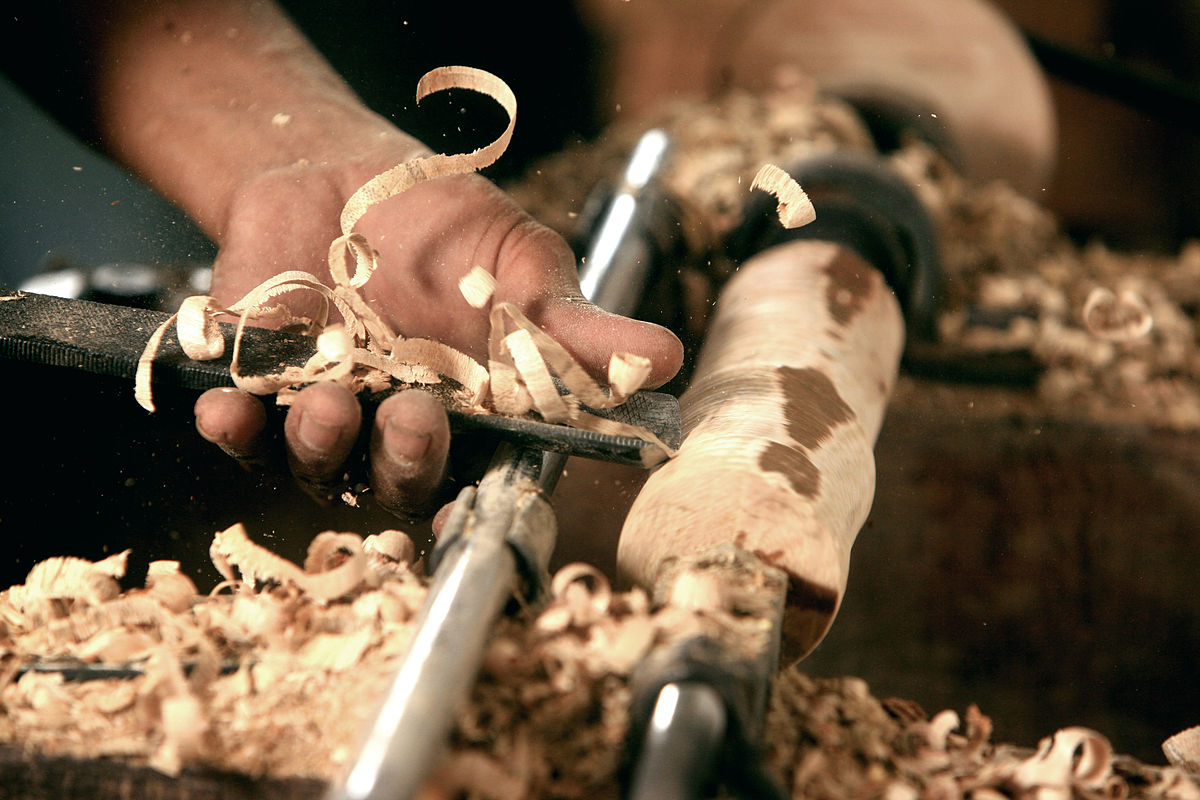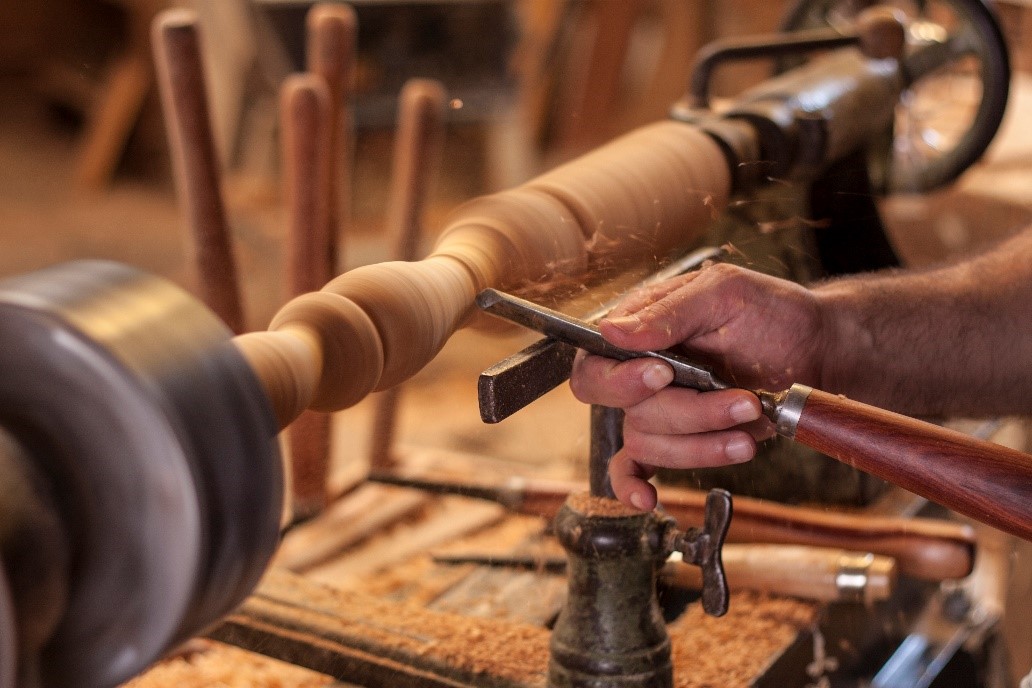Have you ever wondered what people mean when they talk about woodturning? Well, let me break it down for you! Woodturning is a fascinating craft that involves shaping a block of wood into beautiful and functional objects. From bowls and vases to pens and decorative pieces, the possibilities are endless!
So, how does woodturning work? It all starts with a lathe, a machine that spins the wood while the woodturner uses tools to shape and carve it. With skill, precision, and a touch of creativity, the woodturner transforms the raw material into a work of art.
Woodturning is not just about creating something useful or beautiful; it’s also about the sheer joy of working with wood. The process is both meditative and thrilling, as the wood takes shape and reveals its natural beauty. So if you have a love for craftsmanship, a passion for creating, and an appreciation for the beauty of nature, woodturning might just be the perfect hobby for you!
So, are you ready to embark on a journey into the world of woodturning? Let’s dive in and discover the magic of this ancient craft together!

Understanding Woodturning: A Comprehensive Guide
Woodturning is a fascinating craft that allows artisans to transform a simple block of wood into intricate and beautiful objects. Whether you’re a beginner or an experienced woodworker, understanding the art of woodturning can open up a world of creative possibilities. In this article, we will dive deep into what woodturning is, explore the tools and techniques involved, and discover the endless potential that this craft offers.
1. Exploring the Fundamentals of Woodturning
Woodturning is a form of woodworking where a piece of wood is rotated on a lathe to shape it into different designs and forms. The lathe is a machine that holds and rotates the wood, allowing the woodturner to use various tools to remove material and create unique shapes. This craft requires skillful hand-eye coordination and an understanding of wood grain and properties.
Woodturning offers an artistic outlet where you can create items such as bowls, vases, pens, and even intricate sculptures. The possibilities are endless, and the finished products showcase the natural beauty of wood, highlighting its unique grain patterns and textures.
The Woodturning Process:
The process of woodturning involves the following key steps:
1. Wood Selection: Choosing the right type of wood is crucial as it affects the working characteristics and the final appearance of the project.
2. Mounting: The selected wood is securely mounted on the lathe using centers and a faceplate or a chuck.
3. Roughing: The initial shaping of the wood is done using gouges to remove excess material and create a basic form.
4. Shaping: Tools such as gouges, skew chisels, and scrapers are used to refine the shape, create details, and achieve the desired design.
5. Sanding and Finishing: The turned piece is carefully sanded to a smooth finish and then sealed with a protective coating, such as wax or varnish.
2. Essential Tools for Woodturning
To embark on your woodturning journey, you’ll need a set of essential tools. These tools are specifically designed to work with the lathe and allow you to shape and refine the wood. Here are some of the must-have tools for woodturning:
1. Gouges: Bowl gouges, spindle gouges, and roughing gouges are versatile tools used for shaping and removing material.
2. Skew Chisel: This tool is used for refining shapes, creating straight edges, and smoothing surfaces.
3. Parting Tool: A parting tool is used for making precise cuts, separating the workpiece, and creating decorative grooves.
4. Scrapers: Scrapers are used for smoothing surfaces, removing tool marks, and achieving a clean finish.
5. Calipers: Calipers help measure and ensure the accurate dimensions and thickness of the turned piece.
Choosing the Right Wood:
The selection of wood for your projects is equally important as the tools you use. Different types of wood have varying characteristics, including hardness, grain pattern, and color. Some popular wood choices for woodturning include:
1. Maple: Known for its durability and attractive grain patterns, maple is a versatile choice for various turnings.
2. Walnut: Walnut offers a rich, dark color and is popular for creating elegant bowls and decorative items.
3. Cherry: Cherry wood has a warm, reddish-brown hue and smooth texture, making it a favorite among woodturners.
4. Ash: Ash is known for its light color and pronounced grain, making it ideal for showcasing intricate details.
5. Oak: With its distinctive grain patterns and strength, oak is commonly used for larger turned items and furniture components.
3. Techniques and Tips for Successful Woodturning
Achieving mastery in woodturning requires practice, patience, and a deep understanding of various techniques. Here are some essential techniques and tips to enhance your woodturning skills:
1. Tool Control: Maintain a firm grip on the tools and use smooth, controlled movements to shape the wood.
2. Grain Orientation: Consider the direction and orientation of the wood grain to prevent tear-out and achieve better results.
3. Sharpening: Keep your tools sharp to ensure clean cuts and reduce the risk of accidents. Regularly sharpen and hone your tools with the appropriate sharpening systems.
4. Sanding Sequence: Use a gradual progression of sandpaper grits to achieve a smooth surface. Start with lower grits and work your way up to finer grits.
5. Safety First: Always wear appropriate safety gear, including eye protection and a face shield. Learn and follow safety guidelines for operating the lathe and using the tools.
Benefits of Woodturning:
Woodturning offers numerous benefits beyond the joy of creating beautiful objects. Some of the key benefits include:
1. Creativity and Expression: Woodturning allows you to express your creativity and turn your ideas into tangible works of art.
2. Therapeutic and Relaxing: The rhythmic motion of woodturning can be meditative, providing a sense of relaxation and stress relief.
3. Sustainable and Eco-Friendly: By turning discarded or salvaged wood into functional items, woodturning promotes sustainability and reduces waste.
4. Skill Enhancement: Woodturning hones your woodworking skills and opens up opportunities to learn and experiment with new techniques.
Explore the Art of Woodturning:
Woodturning is a versatile craft that offers both artistic expression and functional creations. By understanding the fundamentals, acquiring the right tools, and mastering essential techniques, you can unlock the true potential of woodturning. Whether you’re a hobbyist or aspire to become a professional woodturner, embracing this craft will bring joy, fulfillment, and a newfound appreciation for the beauty of wood. So, pick up your tools, find a lathe, and embark on a journey filled with creativity and endless possibilities.
Key Takeaways: What Do You Mean by Woodturning?
- Woodturning is a form of woodworking that involves shaping wood using a lathe.
- A lathe is a machine that rotates the wood while the woodturner uses cutting tools to shape and carve it.
- Woodturning can create various objects like bowls, vases, and even furniture legs.
- It requires practice, skill, and knowledge of different techniques and tools.
- Woodturning can be a fulfilling and creative hobby or a profession for those passionate about working with wood.
Frequently Asked Questions
Welcome to our Frequently Asked Questions section where we provide answers to common inquiries regarding woodturning. Whether you’re a beginner or experienced woodworker, we’re here to help you understand the fascinating world of woodturning!
1. What tools do I need to get started with woodturning?
When starting with woodturning, there are several essential tools you’ll need to begin your journey. The primary tool is a lathe, which is the machine used to rotate the wood. You’ll also need various cutting tools, such as gouges, parting tools, and skew chisels, to shape the wood as it spins on the lathe.
Other necessary tools include a chuck, which helps secure the wood onto the lathe, and a set of safety equipment, including face shields and dust masks. As you progress, you may want to expand your collection to include specific tools for different woodturning techniques.
2. Can anyone learn woodturning, or is it a skill for experienced craftsmen?
Woodturning is a skill that can be learned by anyone, whether you’re an experienced craftsman or a beginner. While it does require patience, practice, and a steady hand, there is no limit to who can enjoy and excel in woodturning.
There are various resources available, including books, online tutorials, and classes that cater to all skill levels. Starting with simple projects and gradually progressing to more complex ones will help you develop your woodturning abilities. Remember, it’s all about enjoying the process and learning from each turning experience.
3. What types of wood are suitable for woodturning?
A wide range of wood species can be used for woodturning, each offering unique characteristics and aesthetics to your projects. Some popular choices include maple, oak, cherry, walnut, and mahogany. These woods are readily available, easy to work with, and showcase beautiful grain patterns.
It’s important to consider the moisture content of the wood to prevent cracking and warping during the turning process. Green wood, which is freshly cut, requires drying before being used. Alternatively, you can use kiln-dried wood, which has already undergone the drying process, making it a convenient and stable choice for woodturning.
4. What are the basic steps involved in woodturning?
Woodturning involves a series of steps to transform a block of wood into a beautifully crafted object. Here are the basic steps:
1. Mounting: Secure the wood blank onto the lathe using a chuck or other mounting method.
2. Shaping: Use various cutting tools to shape the wood as it rotates on the lathe.
3. Sanding: Smooth the surface of the turned object using sandpaper or sanding pads.
4. Finishing: Apply a suitable finish, such as oil, wax, or lacquer, to protect and enhance the wood.
5. Removal: Remove the finished piece from the lathe and admire your creation!
5. Can woodturning be done in a small workshop or limited space?
Absolutely! Woodturning can be done in a small workshop or even a corner of a room, as long as you have proper ventilation and the necessary tools. Many woodturners create beautiful pieces in compact spaces, utilizing workbenches and organizing their tools efficiently.
If you have limited space, consider investing in a mini or midi lathe, which are smaller versions that fit better in small workshops. Additionally, utilizing mobile tool carts or wall-mounted storage solutions can help maximize space and keep your woodturning area organized and functional.

Beginners Guide to Woodturning Tools
Summary
Woodturning is a cool craft where you use a lathe to shape wood into objects. It’s like a woodworking magic trick!
In woodturning, you start with a block of wood and spin it really fast on the lathe. Then, using sharp tools called gouges, you carefully shape the wood into bowls, pens, and other cool stuff. It’s a fun way to make unique gifts or decorations for your home. So, grab some tools and give woodturning a try!
